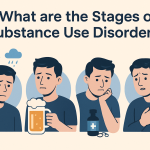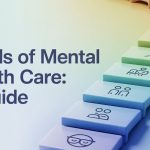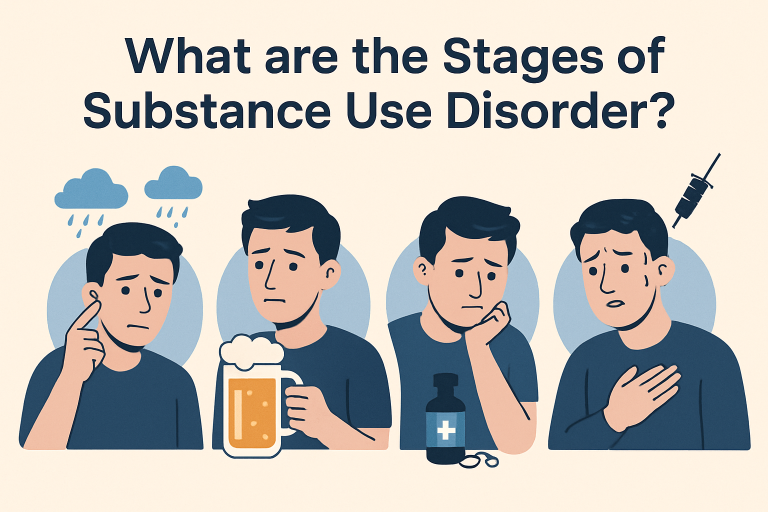Key Takeaways
- The treatment for mental disorders is known to improve quality of life and recovery outcomes.
- There are some common mental health disorders, including anxiety, depression and psychotic disorders.
- There are various causes of mental disorders such as genetic, chemical or environmental.
- Recognising symptoms early can allow timely diagnosis and mental health care.
- Treatments include psychotherapy, medication, and lifestyle changes.
Mental Health Disorders can also be referred to as mental illnesses. These conditions have the potential to influence the way individuals think, feel and act. Moreover, they are also able to destroy relationships, careers and daily life. A report by the World Health Organization in the year 2023 indicates that 1 out of every 8 individuals across the world has a mental health disorder, which is why it is treated as a global priority.
Mental disorders are known to be long-term, unlike short-term stress, and they disrupt normal routines. Mental disorders have a stigma attached to them, which most of the time disheartens people from seeking treatment. These medical conditions should, however, be handled by professionals. The mental disorders are numerous and include things like depression and schizophrenia, which impact millions of individuals annually, regardless of age.
What is a Mental Disorder?
A mental disorder is a medical condition that is known to affect mood, behaviour and cognitive abilities. A mental health disorder, also known as a mental illness or psychiatric disorder, is a condition that affects the way you think and behave. It also influences your emotions and how you regulate them. You may feel anxious or empty, have racing thoughts or have trouble eating or sleeping, as per a non-profit academic medical center.
Unlike occasional stress or sadness, mental disorders continue for a long time and get worse without any treatment or care. They may appear as depression, anxiety, or more complex disorders like schizophrenia. Recognizing these conditions early helps ensure better outcomes.
Here is a Quick Comparison Table to Show Differences Between Stress and Mental Disorders:
Aspect | Normal Stress/Emotions | Mental Disorder |
Duration: | Temporary, improves with rest | Long-lasting, persistent |
Impact: | Minor daily disruption | Major disruption in work, school, and relations |
Treatment: | Self-care, short rest | Professional therapy, medication, and support |
Did You Know?
Anxiety disorders are the most common mental health disorders in the U.S. and nearly 40 million adults are afflicted with the condition annually (NIMH, 2023).
100% Confidential Support is Available 24/7
No matter what you’re going through, you’re not alone. Our dedicated team is here to provide a safe, judgment-free space where you can talk openly and honestly. Whether you need emotional support, resources, or just someone to listen.
We’re here for you—completely confidential and always respectful of your privacy. Call us today!
Common Mental Disorders
The Cleveland Clinic has listed over 200 known mental health disorders. There are, however, some common disorders, which consist of:
- Anxiety Disorders: these are generalized anxiety disorder, panic disorder, social anxiety disorder and phobias.
- Mood Disorders: It is a kind of disease that is characterized by depression and bipolar disorder, which are linked to mood fluctuations and loss of interest.
- Psychotic Disorders: Hallucinations, paranoia, and delusional thinking in Schizophrenia.
- Personality Disorders: The Borderline, antisocial, and narcissistic personality disorders, which affect relationships.
- Eating Disorders: Numerous disorders are associated with food consumption and they may disrupt food consumption, including Anorexia Nervosa, Bulimia and Binge Eating Disorder.
- Substance Use Disorders: Alcohol and drug addiction.
- Neurodevelopment: Autism spectrum disorder and ADHD.
Did You Know? Anxiety disorders are the most common mental health disorders in the U.S. and nearly 40 million adults are afflicted with the condition annually (NIMH, 2023).
Deland Treatment Solutions
Battling with Drug and Alcohol Addition? Remember, you are not alone and we are here to help you!
Difference Between Mental Illness and Mental Disorder
These terms can look similar but have a small difference, which is explained below:
- Mental Illness: It is a clinical diagnosis such as depression or schizophrenia and often linked to biological and chemical causes.
- Mental Disorder: On the other hand, a mental disorder is a broader term that describes patters of disruptive thoughts, emotions or behaviors.
Types of Mental Disorders
Major Categories of Mental Disorders:
Category | Examples | Key Symptoms |
Anxiety Disorders | OCD, PTSD, panic disorder | Excessive worry, fear, intrusive thoughts |
Mood Disorders | Depression, bipolar disorder | Mood swings, sadness, energy changes |
Psychotic Disorders | Schizophrenia, schizoaffective | Hallucinations, delusions |
Personality Disorders | Borderline, antisocial, narcissistic | Difficulty in relationships, unstable mood |
Eating Disorders | Anorexia, bulimia | Obsession with weight, eating habits |
Neurodevelopmental | ADHD, autism | Inattention, developmental delays |
Substance Use Disorders | Alcohol, opioid addiction | Dependency, withdrawal, cravings |
Mental Disorder Symptoms
Symptoms of mental health disorders may be emotional, cognitive, or physical:
- Emotional: Persistent sadness, irritability, or extreme mood changes.
- Cognitive: There can be confusion, lack of focus and irrational fears.
- Behavioral: It may manifest itself through withdrawal, drug abuse, or alterations in diet or sleeping habits.
- Physical: Headache, fatigue or headache without any cause.
Red Flag Pointers:
- Those symptoms that take more than 2 weeks.
- Disruption of school, work or relationships.
- Self-homicide or suicide ideation.
Begin healing through professional mental disorder therapy at DeLand Treatment Solutions today!
Mental Disorder Causes
Mental disorders develop due to multiple factors:
- Genetics: Family history raises risk.
- Brain Chemistry: The neurotransmitter imbalances, such as the problems with serotonin, also predispose to mental disorders.
- Life Experiences: In case an individual has caused trauma, abuse, or chronic stress, then he or she must be prepared to deal with some disorder.
- Environment: The major factors also include environmental issues like poverty, isolation, and the absence of support.

Biological Causes | Environmental Causes | Lifestyle Causes |
Genetics | Trauma, abuse | Substance misuse |
Brain chemistry | Social isolation, poverty | Chronic stress |
Medical illness | Unhealthy surroundings | Poor sleep/nutrition |
Fact
Mental illnesses are common in the USA and around the world. It is estimated that more than 1 in 5 U.S. adults live with a mental illness.
How are Mental Disorders Diagnosed?
There are various methods for the diagnosis of mental health disorders; some of them are:
- Medical Tests: Through these tests, one can exclude physical conditions.
- Psychological Evaluation: There are several Questionnaires, interviews, and observations conducted.
- DSM-5 Criteria: They are diagnostic guidelines that are standardized.
Tip: It would be optimal to keep a symptom diary. This information can assist physicians in learning the trends and making the process better.
Experts advise: Treat mental disorders early, as Treatment is best when the symptoms are recognized early.
How to Treat a Person with a Mental Disorder?
Treatment of a person with a mental disorder needs empathy and time:
- Do not make such dismissive statements as to relax.
- Promote the search for therapy or care services.
- Assist in day-to-day activities.
- Know emergency contacts
Note: Compassion assists healing besides the professional treatment of mental disorders.
Treatment Options for Mental Disorders
The treatment is dependent on the condition and may involve:
- Psychotherapy: CBT, DBT, and group treatment.
- Drugs: antidepressants, mood stabilizers, and antipsychotics.
- Lifestyle Interventions: Exercise, nutrition, and mindfulness.
- Support Services: Rehabilitation programs, peer groups.
- Advanced Care: ECT, TMS.
Treatment Snapshot Table:
Approach | Works Best For | Example Tools/Treatments |
Psychotherapy | Anxiety, depression, trauma | CBT, DBT |
Medication | Severe depression, psychosis | Antidepressants, lithium |
Lifestyle Care | Mild to moderate disorders | Exercise, yoga |
Advanced Care | Resistant or severe conditions | ECT, TMS |
Mental Disorder Treatment and Prevention
Preventive strategies reduce the likelihood of common mental disorders:
- Exercise Regularly: Improves mood-regulating chemicals.
- Balance Meals Every Day: Benefits the brain.
- Social Support: Find friends and family.
- How to cope with stress: Meditation and relaxation.
- Seek Care Early: Symptoms should not be disregarded.

How DeLand Treatment Solutions Can Support You
At DeLand Treatment Solutions, we help individuals navigate mental health challenges with practical solutions tailored to each person’s needs. Our team provides therapy, medication guidance, lifestyle advice, and structured programs to support recovery and daily functioning. If you or someone you care about is facing mental health difficulties, visit DTS or call (386) 866-8689 for guidance and support.
Conclusion
- Mental disorder treatment improves quality of life.
- Common mental health disorders are manageable with early diagnosis.
- Causes include genetics, brain chemistry, and life experiences.
- Types of mental disorders vary, but respond to therapy and medication.
- Prevention and lifestyle choices reduce risk.
- Professional mental health care ensures better outcomes.
Frequently Asked Questions
What are the life-threatening mental disorders?
Schizophrenia, bipolar disorder and severe depression are examples of serious mental disorders. This is to ensure that they are treated at all times to avoid complications. With diagnosis and personal treatment of mental disorders at early age, many people can manage the symptoms and live a good life.
What are the 7 most prevalent mental disorders?
These 7 groups are depression, anxiety disorders, bipolar disorder, schizophrenia, personality disorders, eating disorders and substance use disorders. Everything is classified as a sub-head of mental disorders. Lifestyle modification, prescription of drugs and therapy usually go hand in hand.
What is the major cause of mental disorder? Genetic or Environmental? Is it genetic or environmental mental disorders?
Mental health disorders have been a result of genetic and environmental factors. Family history exposes the vulnerability, although the triggers can be stress, trauma, or substance use. These two influences are considered when proper treatment of mental disorders is done.
What are the common mental disease symptoms?
The symptoms include mood swings, sadness, withdrawal of activities, and change of sleep or appetite, as well as difficulty in focusing. Unchanging patterns must be professionally addressed and dealt with.
How can I tell if someone has a mental disorder?
Weekly changes in mood, thinking or behavior. Consult a professional in case of any misunderstanding or emotional torment.
What are the common mental health disorders?
The most common are anxiety and depression, followed by bipolar disorder and substance use disorders. Early treatment minimizes the effects.
How are Mental disorders treated?
Mental disorders are treated by the use of psychotherapy, medicines, support systems as well as lifestyle changes. In severe cases, they will be admitted in hospitals or subjected to advanced treatment.
Is the solution to prevent mental disorders in lifestyle changes?
Healthy habits like physical activity, rest, nutrition and social interaction minimize the risks. There are predispositions that are caused by genetics but treated by preventive measures and intervention at early ages.


















